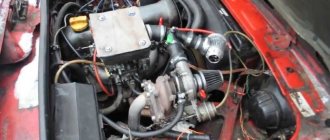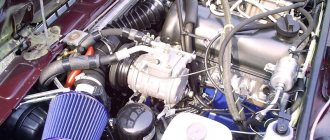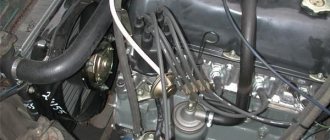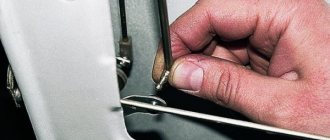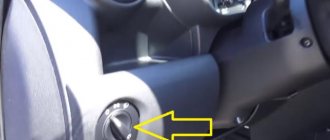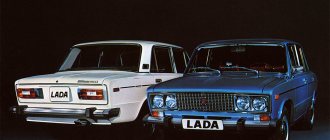Installation of a turbine on a VAZ 2107
Installing a turbine allows you to double the power of the VAZ 2107 engine without increasing fuel consumption.
Reasons for installing a turbine on a VAZ 2107
Installing a turbine on a VAZ 2107 will allow:
- reduce vehicle acceleration time;
- reduce fuel consumption of injection engines;
- increase engine power.
Turbine operating principle
To increase engine power, you need to make the supply of the fuel-air mixture to the combustion chambers more intense. The turbine crashes into the exhaust system, is driven by a stream of exhaust gases and, using the energy of these gases, increases the pressure in the power unit. As a result, the rate of mixture entering the cylinders increases.
Under normal conditions, the VAZ 2107 engine has a gasoline combustion rate of about 25%. After installing a turbocharger, this figure increases noticeably and the engine efficiency increases.
Choosing a turbine for VAZ 2107
There are two types of turbines:
- low-performance (boost pressure 0.2–0.4 bar);
- high-performance (boost pressure 1 bar and above).
Installing a second type turbine will require a major engine upgrade. Installation of a low-performance device will ensure compliance with all parameters regulated by the automaker.
Before turbocharging the VAZ 2107 engine you will need:
- Intercooler installation. When using a turbine, the air heats up to 700 o C. Without additional cooling, not only can the compressor burn out, but the engine itself can be damaged.
- Conversion of a carburetor fuel supply system to an injection system. A weak intake manifold on carburetor engines will not withstand the pressure of the turbine and may rupture. On units with a carburetor, you can install a compressor instead of full turbocharging.
In general, the advantages of the VAZ 2107 turbocharged engine are very doubtful. Therefore, before installing a turbine on a discontinued car with modest technical characteristics, you should carefully evaluate the feasibility of the decision being made. It is much easier to install a compressor on a VAZ 2107. In this case:
- there will be no excess pressure in the system that could destroy the manifold, car suspension, etc.;
- no need to install an intercooler;
- no need to convert the carburetor system to an injection system;
- the cost of re-equipment will be reduced - the complete compressor costs about 35 thousand rubles, which is much lower than the cost of the turbine;
- Engine power will increase by 50%.
I had to watch with my own eyes how a VAZ 2107 with a turbocharged engine rushes. It is difficult to overtake it on the highway, but the car cannot maintain speed for a long time, in my opinion, although I have not driven it myself.
Advantages and disadvantages of combined supercharging
The undoubted advantage of combined supercharging is the absence of the “turbo lag” effect. The engine begins to produce its Newton meters almost from idle. This is necessary not only for those who like to “light up” at a traffic light, but also helps a lot in traffic jams, helping to easily move away without spinning the engine.
However, there are still more negative aspects. First of all, this is the high cost and complexity of production. And in the event of a breakdown, you will have to pay a considerable amount at a car service center. Moreover, the turbine, mechanical supercharger, electromagnetic clutch, drive belt and pipes take up a lot of space under the hood. This makes maintenance extremely difficult. And even if minor repairs are necessary, literally half the car has to be disassembled.
Installing a turbine or compressor on a VAZ 2107
There are two ways to install a turbine on a VAZ 2107:
- through the intake manifold;
- through the carburetor.
The second option is more effective, as it provides direct formation of the fuel-air mixture. To complete the work you will need:
- a set of wrenches and screwdrivers;
- drill;
- containers for draining refrigerant and oil.
Connecting a turbine or compressor to the exhaust system
The turbine will require a certain amount of space in the engine compartment. Sometimes it is installed in place of the battery, which is transferred to the trunk. For the VAZ 2107, a turbine from a diesel tractor is suitable, which does not require water cooling and is connected to the standard exhaust manifold. The principle of its operation is based on the circulation of hot exhaust gases, which, after spinning the turbine, return back to the exhaust system.
The turbine installation algorithm depends on the engine type. For the naturally-aspirated power unit of the VAZ 2107, it will be necessary to further reduce the geometric compression ratio by installing the original intake manifold (if it is missing).
Lada Signet GL
Few people know about this fact: there was a time when AvtoVAZ cars were sold on the North American continent. Among the models exported overseas was the “seven”, which in Canada was known as the Lada Signet GL. This car differed from the Soviet version by reinforced bumpers that met the safety requirements of that country.
In addition, Canadian dealers modified Ladas to their own technical standards: lighting technology, seat belt signal, improved interior trim and exhaust system catalytic converter. Some versions had fancy tires with white sidewalls.
Turbine check
Before installing the turbocharger, it is recommended to change the oil, as well as the air and oil filters. The turbine is checked in the following order:
- the oil drain and supply parts of the compressor are inspected for the presence of foreign impurities;
- the catalyst is checked (excess exhaust gases will negatively affect the operation of the compressor);
- all air supply channels are inspected for dirt and blockages;
- The rotor rotation speed is checked.
In other words, checking a turbocharger comes down to:
- control of the quality and quantity of gases released from the collector;
- checking the quality of fresh air supply to the compressor;
- checking the output of hot gases from the turbine;
- checking the compressed air output from the compressor.
Video: testing a tractor turbine on a VAZ 2107
Thus, installing a turbocharger on a VAZ 2107 is quite complicated and expensive. Therefore, it is easier to immediately turn to professionals. However, before this, it is necessary to carefully evaluate the feasibility of such tuning.
04/12/2013 10:22 2013-04-12T06:22:54.000Z
Description:
Due to numerous requests to show the turbo classics and because ordinary guys who drive sixes, sevens, kopecks, dream of their car driving, driving and pulling Mercedes without any problems - today in the tuning section turbo seven from Zhorik Revazov!
There is a turbine from a diesel tractor here, but it fully performs its function of blowing up the engine. The battery is moved back and a turbine is installed in its place. The outlet from the exhaust manifold is a turbo manifold wrapped with thermal tape. A turbine is placed on the collector; it does not require water cooling, which will not cause installation difficulties.
The turbine on the VAZ 2107 is considered exotic among car enthusiasts. And the power advantages of turbo engines over their factory counterparts are driving the proliferation of passenger cars equipped with turbines. And not only among foreign cars...
In theory, their main goal is to achieve maximum horsepower. For fans of fast driving, this is the main argument for sure. Given the same displacement, a turbocharged engine is characterized by almost double power with standard fuel consumption. In modern conditions, small-displacement turbo engines are very relevant.
Turbocharging VAZ 2107
The conventional division of the turbine provides for 2 groups:
- With low pressure up to approximately 0.2-0.4 bar.
- With high pressure up to 1 bar and above.
Installing a high-pressure turbine requires significant modifications to the engine, and when installing a low-pressure unit, almost all factory elements of the system can be preserved.
Misconceptions when choosing a compressor. Performance and pressure
There are several misconceptions and myths that come up when purchasing a compressor. 20 years of experience at pnevmo.ru has shown that many customers have difficulties even with the basic parameters of the compressor: capacity and pressure. For example, what is compressor capacity?
Logically, it is clear that this is the amount of air that the compressor pumps per unit time. What is the suction capacity of piston compressors? In our opinion, this is a theoretical performance that is defined as the product of the cylinder volume (piston area multiplied by the piston stroke) and the crankshaft rotation speed. It is quite different from the real one, often overestimating the value by 30%. 40% By the way, one of the most honest compressor manufacturers is the Bezhetsk plant ASO, which, unlike others, publishes real performance values.
How to check the performance of a piston compressor? It is logical to assume that you need to take a stopwatch and time how long it takes the compressor to pump up the empty receiver
I draw your attention to the word empty - water always settles in the receiver and if it is not drained, the results will be overestimated. Next: the water is drained, the stopwatch is ready, we turn on the compressor and note the time... and we get the wrong answer. The fact is that if the compressor pumps receiver up to 10 bar, then it will pump up to 1 bar quickly, up to two a little slower, and so on, where the pumping time from 9 to 10 bar will be the longest. This is especially true for compressors with one compression stage. Therefore, it would be more correct to measure the time after stopping the compressor at 10 bars and starting at 8, these two bars will show the real performance
Why is that? Because a piston compressor must work intermittently, and if this does not happen, it means that the compressor is selected incorrectly. Depending on the type, the compressor must rest from 20 to 50% of the time.
Operating pressure is the pressure at which the compressor operates in normal mode.
Reciprocating compressors are equipped with a pressure switch, which is usually set to a difference of 2 bar. If the compressor turned off, for example, at 10 bars, and turned on at 8, then what pressure is considered working: 10 or 8? In our opinion, it is more correct to assume that 8. If you have 7 bar in the line, then 8 at the outlet of the compressor, through the gearbox, is considered normal. If it drops below 7bar, it means the compressor performance is not enough. Many people believe that it is better to take a compressor with a reserve, say for a pressure of 13 bar, so that 10 is guaranteed in the system. If your equipment operates from 6-7 bar, then buying a 13-bar compressor will only lead to unnecessary electricity costs, approximately 25-30% to the detriment of performance.
To avoid such misunderstandings, we recommend purchasing screw compressors. They are more reliable and efficient and do not have the same features as piston ones. But again, I repeat, you don’t need to take a 10-bar compressor if you have 7 in your system. It’s better to take an 8-bar, since its performance will be higher than that of a 10-bar at the same price.
Source
Visual installation
A sample with a low-pressure turbine and a VAZ 2107 engine with distributed injection involves the use of the following factory parts: cylinder block, crankshaft, connecting rods, camshaft and valves. The difference in additional components is associated only with the pistons and cylinder head due to the need to reduce the compression ratio during installation. This functional feature is achieved by enlarging the combustion chamber or special pistons. However, there is a theory that the pistons can be factory pistons and you can limit yourself to replacing the head.
The injector output also differs. The turbine fills the space between the exhaust pipe and the exhaust manifold. The factory model remains the resonator and muffler. If you need to obtain more power, still use the recommendations for installing a direct-flow exhaust. Injection requires an enlarged receiver and a non-standard control program. The lubrication system also undergoes minor changes. Summarizing the above, we can conclude that the turbine itself will be the most expensive and scarce part.
What is a turbocharged engine in a car?
The first turbocharged engines were designed back in 1905, but they began to be installed in passenger cars in the second half of the 20th century.
Turbocharging is a system of forcing additional air into the cylinders of an atmospheric engine, resulting in an increase in the average effective pressure in the cylinders. This increases the power of the motor without making changes to its design. The operation of a turbocharged engine is ensured by a drive supercharger that uses the energy of exhaust gases. They drive the turbine wheel, which in turn rotates the compressor wheel using a rotor shaft. The compressor wheel compresses the air, which is heated, and after entering the intercooler, it is cooled and supplied to the cylinders. Until recently, turbocharged engines were installed exclusively on expensive sports car models. But, according to marketers, currently the share of models with such engines is rapidly increasing, and the turbine is becoming almost a mandatory element of prestigious car brands.
Turbines are installed much more often on diesel engines than on gasoline ones.
Car manufacturers emphasize that turbo engines are mercilessly crowding out naturally aspirated engines, and most buyers of good cars prefer this type of engine. But is a turbo engine as good as the designers and engineers of automobile companies describe it? To draw conclusions, it is worth considering its design features and taking a closer look at the principle of operation.
Design features
The turbocharging system consists of a compressor, intercooler, boost pressure regulator and other components. The main part is the turbocharger, which regulates the increase in pressure in the air intake system. The intercooler cools the air and increases its density.
Air movement pattern during operation of a turbocharged engine
The entire system is controlled by a boost regulator. This is a bypass valve that limits the exhaust gas pressure. By cutting off a certain amount of them, the valve makes the boost pressure optimal.
The turbocharger works as follows:
- The air passes through the air filter and enters the inlet.
- The air is compressed and its oxygen content increases. The air heats up and its density decreases.
- The air masses leave the turbocharger and enter the intercooler, where cooling occurs.
- Compressed air penetrates through the throttle and intake manifold into the engine cylinders.
- Part of the exhaust gases generated during the combustion of fuel in the cylinders is transferred by the turbo engine back to the turbine manifold. This air flow starts the movement of the shaft, at the opposite end of which the compressor is located. This is where the recompression of the air begins.
Turbocharger diagram
Principle of operation
Why is it that the turbine attracts vehicle owners to the injector? Everyone knows the fact that the volume of fuel that burns out in the cylinders is closely related to the amount of air absorbed into the middle of the engine when starting up by the injector. And the fulfillment of the mass ratio condition, numerically expressed as 1 kg of combustible mixture to 15 kg of air, is mandatory. After all, subsequent enrichment of the liquid implies a decrease in power. In order to remove this obstacle, the cylinder requires more air supply by pumping it into excess pressure. Thus, an increase in air pressure by 30% triggers an acceptable increase in power and acceleration dynamics.
Turbocharger malfunctions
Turbine installation: brief description, features, diagram and reviews
The turbocharger is a very simple and reliable unit and, it would seem, there is simply nothing to break in it. However, this is not so; there are many types of turbocharger malfunctions, and all due to the colossal loads that the unit experiences during operation.
One of the main reasons for turbocharger failure is insufficient oil supply. The turbocharger shaft spins up to 75,000 revolutions per minute during operation, and if there is a lack of oil, the bearings in which the shaft rotates can fail in a few minutes. A slight displacement or runout of the shaft can lead to its destruction, as well as to serious damage to the wheels of the turbine and compressor, and complete failure of the entire unit.
Interestingly, it is the lack of oil that most often causes turbocharger breakdowns. The whole point is that the unit is powered by oil from the engine, so it can fail even when the engine is stopped running at high speeds. Indeed, in this case, the turbine shaft rotates at high speed, and after stopping the engine, oil stops flowing into the turbocharger, and the shaft rotates in “dry” bearings (and due to the colossal speed, rotation can last for several minutes). In most cases, bearing failure is caused precisely by failure to comply with the basic rules of operating a diesel engine with a turbocharger.
Also, quite often the turbocharger fails when foreign objects get into it. Moreover, the rotor, rotating at enormous speed, does not need a stone to break - just a small fragment of a piston ring or valve is sufficient. And damage to the compressor rotor is possible even if a piece of rubber or fabric gets into it - in this case, the blades usually do not break, but bend, as a result of which the characteristics of the turbocharger sharply deteriorate.
There are other reasons for turbocharger breakdowns, but in most cases there is only one solution to the problem - buying a new unit. But why? Wouldn't repairing a turbocharger be cheaper? No, it will not. More precisely, the repair itself will require less cost than buying a new unit, but after repair the turbocharger does not “go away” for long, and soon it will still have to be replaced.
The difficulty of repairing turbochargers lies, again, in the loads to which it is subjected. Here, very high precision is required during the installation and processing of parts, and deviations even of microns will lead to rapid failure of the repaired unit. For such work, the use of specialized high-precision equipment and tools is required, so only the repair of expensive turbochargers is justified. And since KamAZ turbochargers are low in price, no one undertakes to repair them - it’s easier and more profitable to buy a new unit.
Final result
During the research, the turbine installed on the VAZ 2107 engine injector showed the following results: provided that the clutch and tires are of high quality, the acceleration time to 100 km/h is reduced by 5 seconds (compared to the base engine). The same principle applies to elasticity: acceleration time in 4th gear from 60 to 100 km/h is also reduced by 5 seconds.
The idea itself is simple. However, it is difficult to implement it on the VAZ 2107. Representatives of companies that will undertake the production of turbochargers are counted on the fingers of one hand. But turbine kits for installation on a conventional injector began to appear on the market. The kit includes all the pipes, a new block cover, the turbine itself and the intercooler.
The difficulties of installation and further adaptation to the injector are as follows:
- The exhaust gas temperature level that the turbine must withstand is theoretically between 900˚C and 950˚C.
- The working speed of the rotor injector with the impeller is numerically represented not only in tens, but in hundreds of thousands of revolutions per minute.
- The functional resources of the volume of engine compartments of passenger cars are limited, and therefore require the manufacturer to place the unit within a specific framework.
Based on the above, a turbocharger must have high heat resistance, be compact, well-balanced, and at the same time inexpensive.
How to install an air blower yourself
There are several approaches that allow you to install a mechanical air blower on VAZ family cars with your own hands. This means making a device yourself that provides turbo mode or boosting the engine, or using a ready-made KIT kit.
Homemade supercharger for VAZ
With this approach, the mechanical air blower will be decisive. The entire future design depends on it. The main thing is to find an air supercharger from an imported car that meets the requirements, or you will have to use a homemade one. This is also possible, and in this case suitable parts and components from completely unexpected devices, for example, a vacuum cleaner, are used.
When making such a homemade air supercharger, you need to take literally everything into account - dimensions, weight, placement in the engine compartment, how and where the drive pulley and belt will be located, the performance of this device, operating modes (short-term or long-term), the possibility of lubrication and much, much more. Once the compressor becomes clear, it is necessary to calculate the implementation of the turbo mode for the engine.
Even the far from complete list of questions shown shows that making a homemade air supercharger for a VAZ of any family, be it 2107, 2106, 2114, 2112, is quite difficult, but possible. An example would be a photo showing that such work has been successfully completed. True, this is not a VAZ, but the fact itself is important - it is possible to make a homemade air compressor in which its drive unit is connected to the engine crankshaft.
Do-it-yourself drive supercharger - from a KIT kit
Yes, there are such kits on sale that allow you to implement the turbo mode in VAZ 2107, 2106, 2114, 2112 cars with your own hands. As a rule, it includes everything needed to assemble and install such a device on a car - the compressor itself, belts, drive unit , brackets and air ducts. What such a kit is like can be seen in the photo below.
As an advantage of implementing the turbo mode in this way, it is worth noting that it is tailored specifically to VAZ cars of one model or another (2107, 2106, 2114, 2112). The advantages of this approach also include the fact that under some conditions, when the level of additional pressure created is not more than half a bar, no intervention is required in the vehicle’s fuel system.
It is inappropriate to describe the procedure for implementing the turbo mode from such a set; each of them has its own assembly instructions. The disadvantages include the country of origin, but it depends on your luck. The video will additionally help you understand what the car looks like after modification and how to carry it out » alt=»»> One of the ways available to car enthusiasts to boost the engine of an old car and give it a new life is to install an air supercharger. You can do this work yourself if you use commercially available KIT kits for VAZ cars.
Is the installation justified?
Tuning a VAZ 2107 carburetor in the form of installing a turbine requires a balanced decision. Do not forget that the VAZ 2107 is an outdated passenger car in all respects. For an adequate owner, modification of the engine with a gas turbine supercharger is purely theoretical. In practice, this is a series of problems unworthy of attention.
The seventh model of Zhiguli does not itself provide for the use of a turbine as such. The manufacturer did not provide for the possibility of introducing such a unit at the design stage. For stubborn amateurs who have installed a turbine on an injection-type engine, there is no problem with the injector itself.
From a technical point of view, such an installation on the VAZ 2107 is acceptable. However, it is impossible to escape without consequences:
- A passenger car is not designed to withstand the loads that a suddenly stronger engine will impose on it.
- In addition to the suspension, other components may be damaged.
- The exhaust manifold, for example, may simply not withstand the gas pressure that the turbine will supply to it.
Installing a turbine on a VAZ requires a special base. Amateur replacement carries certain risks. For example, the exhaust manifold may not withstand the high pressure created by the turbine. People are adults - the consequences are clear to everyone. Such engine modernization can be done by professional service center workers.
Experimental method
Undoubtedly, a more complex and time-consuming path, in which there is a clear advantage - tuning the VAZ 2107 engine, in this case will be purely individual and ideal for your car.
So, first of all, we need a compressor for the injector made abroad
The main thing is to pay attention that the part matches all the characteristics of the VAZ 2107
Worth considering:
- Size, weight, volume and, most importantly, performance and diameter of both inlet and outlet pipes.
- Short-term and long-term maximum possible supercharger speeds.
- Maximum overpressure.
It is also important that the compressor has its own independent lubrication system so that no intervention is required in the standard mechanisms of the VAZ 2107. To put it simply, it is necessary:
To put it simply, you need:
- Consider the mounting principle and drive of the compressor itself, gears or a tension belt are possible.
- Calculate the required fuel system performance.
- Take into account all necessary modifications to the engine so that the system can interact normally with the compressor.
- Carry out the necessary CHIP tuning to reconfigure the engine and adapt it to new parameters.
The list goes on and on, depending on which compressor you choose. And what results do you expect from upgrading the engine in the end?
There is no need to hide that the project described above has a number of very unpleasant disadvantages. Here are just a few of them:
- The need for an individual project, which results in its complexity and high cost.
- The need for significant modification of the VAZ 2107 engine.
- Rare engine components will have to be assembled in parts.
- You will have to use the help of qualified craftsmen, which is again very expensive. You can get down to business if you have the skills of an advanced auto mechanic. Otherwise, tuning may lead to failure of the injector or the engine itself.
The advantages include the following:
- After such tuning, the car will become truly exclusive.
- If you do everything yourself, you will be able to establish yourself as an excellent auto mechanic. Who knows how to disassemble and reassemble a car down to the last screw.
It is easy to conclude that the disadvantages still significantly outweigh. That is why today drivers practically do not use the experimental method, preferring to purchase and install a ready-made KIT kit.
Turbo kit Garret 1752
What is the difference between a turbine and a compressor and which is better?
Turbo kit Garret 1752
Turbines from Garrett are consistently among the favorites among VAZ owners.
Among the circumstances of this:
- sold as a ready-made set, there is no need to assemble individual elements using spare parts at car dismantling yards;
- relatively low price (a new set will cost 30-35 thousand, used ones can be found in the range from 15 to 25 thousand);
- without any special modifications, you can remove the boost from the car to 0.5 bar, increasing power to 120-130 hp. and torque up to 180-200 Nm;
- with additional modifications to the boost system, the boost can be increased to 1 bar, power – up to 170-200 hp, and torque – up to 240 Nm.
The boost kit from Garret is optimal for novice fans of turbo tuning. By setting the boost to 0.5 bar, you can get a good increase in power without reducing the life of the engine. For harsh “rides”, this option is not suitable due to its limitations.
Atmospheric petrol engine with a volume of 1.8 l
Since September 2014, it has been producing and selling Priora cars equipped with an increased displacement engine. The basis for the new power unit was the VAZ-21126 engine, the working volume of which increased to 1.8 liters due to the extended piston stroke. The motor received the designation 21128, but it will not be produced in large quantities - assembly is carried out only in the Super-Auto workshops.
Sedan LADA Priora 1.8L, 2014 model year
The characteristics of the power unit, designated by the numbers 21128, look interesting: a torque of 145 N*m is achieved already at 2500 rpm. It would seem that such an internal combustion engine has the right place under the hood of a crossover. But in reality, Super-Auto assembles no more than five hundred engines a month. And all of them are intended for Prior.
Let's continue talking about Kalina Cross. There are two engines for this model: 21116 and 21127. The first of them will be available in the “Norma” configuration. And the second one, perhaps, can be supplemented with a robotic gearbox, which is built on the basis of a cable manual transmission.
